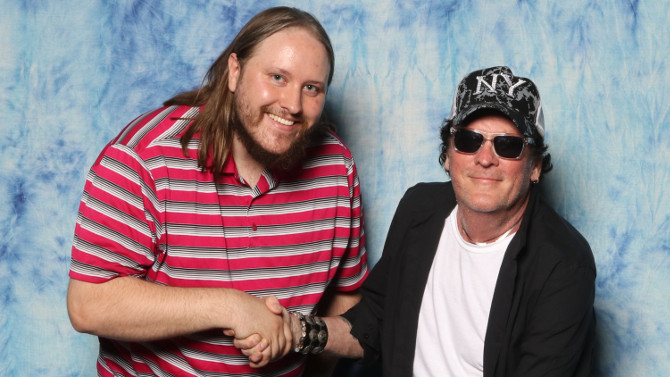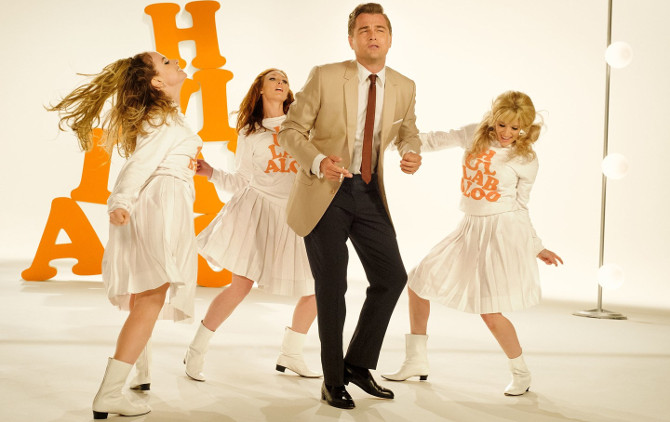Once upon a time. . . in Hollywood, a young man named Quentin was fascinated with all things movies. So much did he love those moving pictures of the silver screen that he found a job at the Video Archives, a rental store in Manhattan Beach, California. And, almost like a fateful fairy tale scene in one of his beloved movies, a young Tarantino somehow found his way into the business, becoming a director of success and acclaim. Utilizing his unique vision, he re-purposed those films that he devoured in his long hours at the video store, bringing history alive with a modern spin, melding past and present in most unique ways. With a romantic brainstorm, the acclaimed filmmaker decided that ten motion pictures would encompass his entire filmography, making his most recent effort, Once Upon a Time … in Hollywood, his second last, a narrative that turns a loving eye to his fantastical hometown – all I’m missing is voice over work from Kurt Russell, and I’ve got the beginnings of my intro to a documentary on the man.
A revisionist history of 1969 Los Angeles, Quentin Tarantino writes and directs his least focussed picture, a meandering love letter to the City of Angels. Born in 1963, the filmmaker, who was only the tender age of six the year the movie is set, utilizes his vast knowledge of television and movies to build a vivid picture of that time. Though, by doing so, it also makes for his least accessible feature to date. . . for not only is there graphic violence, much like all of his other pictures, but, to my estimation, you also have to be a passionate film history buff while also needing to have a love for the way movies are crafted to truly appreciate what Tarantino is doing here.
Flashing back, forward, and between multiple storylines, the narrative’s co-protagonists are Rick Dalton (Leonardo DiCaprio) and Cliff Booth (Brad Pitt), an actor and stunt double pair attached at the hip. In reality, Booth is much more. . . an all-round handyman and chauffeur, it is a case of ‘me and my shadow’. Pitt plays the role along the lines of Tom Laughlin, aka Billy Jack, a cool, even keeled antihero who just happens to be tough as nails, and is never fazed by any situation – not even the most pressing. If you know the above mentioned Billy Jack, a few scenes from Once Upon a Time are definitely re-imaginings of scenarios you could have seen in it or its sequels. Yet, the actual loyalty and comradery of the friendship between the two is actually inspired by the relationship between Burt Reynolds and stunt man Hal Needham.
An amalgam of many chiselled actors that were popular in the 1950s and early 60s (think along the lines of Tab Hunter or Chuck Connors), the changing times find the former star actor (of both film and television) struggling to find quality work as studios look for scraggly haired individuals to capitalize on the growing hippie movement.
Relegated to one-off roles as the villain of the week in television series, Dalton has lost his confidence, despite still being a recognizable face. . . even on the mind of agent Marvin Schwarzs (Al Pacino) – the man wants to send him to Italy to make some westerns and get some semblance of stardom back (though the actor is apprehensive – not having a very high opinion of those types of movies).
In an alternate storyline, Roman Polanski (Rafal Zawierucha) and Sharon Tate (Margot Robbie) have moved right next door to Dalton – frequently having friends over, including her former lover Jay Sebring (Emile Hirsch). With her star rising, Tate has previously appeared in The Valley of the Dolls and is currently featuring in the Matt Helm flick The Wrecking Crew.
Playing with multiple genres, at times it seems like a behind the scenes documentary on Dalton – highlighting his successes, failures and crippled emotions. One scene finds him butchering a take on a new pilot (Lancer) opposite star James Stacy (Timothy Olyphant), Tarantino capturing the camera being reset as it has to happen all over again (a second take). . . his freak-out in his trailer follows – a self-intervention in which he challenges his issues with alcoholism, further claiming that he will quit (only to take a swig from his hip flask a few seconds later – throwing it out of his trailer in disgust immediately afterward). Later, he finally recaptures a touch of former glory, tears coming to his eyes as an eight year old method actress (Julia Butters) tells him, soon after filming has completed, that it was the best scene she has ever shot with an actor. . . creating a roller coaster ride of emotions.
At other times, it plays like a unique combination of horror and western. . . specifically a sequence which finds Booth arriving at Charles Manson’s ranch. As he walks the dusty central road, ragged hippies (with ominous dead eyes) gaze from the decrepit former western television set, a combination of The Hills Have Eyes and a Sergio Leone spaghetti western (look for shots from the hip, cuts to staring visages, and the camera lifting up from the feet to the head – all examples of superb, western and horror inspired camera work found here). It is tense, terse, and daunting. . . a playful twist further impressing. The suspense of a murderous thriller is also experienced, for I am not sure if I’ve ever felt a more unnerving sequence. . . the movie flashes forward six months as The Rolling Stones’ Out Of Time blares – “I said, baby, baby, baby, you’re out of time” rings out as the cold neon lights of LA come alive, and Kurt Russell’s narration tells every minute detail of the lead up to the epic ending. Yet, like much of Tarantino’s work, it is also a quirky comedy. You may find yourself crying with laughter while watching a confrontation between Booth and Bruce Lee (Mike Moh), while several other moments, which I will not ruin, may have you giddy with comedic excitement.

Filmizon.com’s Nikolai Adams with Michael Madsen, who has a cameo in Once Upon a Time … In Hollywood as the Sheriff on the television series Bounty Law
Also, like a game of Where’s Waldo, it is a whole lot of fun spotting performances from so many excellent character actors, from previous Tarantino collaborators like Michael Madsen, Kurt Russell, Bruce Dern, and Zoë Bell, to Tarantino newcomers Dakota Fanning, Luke Perry (in his final onscreen role), Damian Lewis (as Steve McQueen), Lena Dunham, Maya Hawke (daughter of Ethan Hawke and Uma Thurman), Rumer Willis, Rebecca Gayheart, and Margaret Qualley. . . this should give you an idea of the large ensemble cast. Likewise, the soundtrack is its own listening game – the film’s two hour and forty-one minute runtime embraced by the vocals of Neil Diamond, Paul Revere & The Raiders, Simon & Garfunkel, Joe Cocker, Bob Seger, Deep Purple, Aretha Franklin, Mitch Ryder & The Detroit Wheels, The Mamas and The Papas, The Box Tops, etc.
And, like in every Tarantino flick, there is so much more. At one point, Tate and Sebring enter a restaurant and discuss a dirty movie that is having its premiere (Sharon is surprised erotic films have premieres). . . the theatre is actually the Eros, which used to run pornos and is now owned by, none other than, Quentin Tarantino – now a repertory cinema called The New Beverly. A true film fan, Tarantino even painstakingly had artists recreate spaghetti western posters for the movies Dalton stars in – a nice touch to succinctly depict the work the character does in a short amount of time. Another nice touch finds the set of Django Unchained re-purposed for the set of Dalton’s series ‘Bounty Law’ – a wink wink/nudge nudge of how Hollywood sets often appear in multiple movies. . . deja vu anyone?
A movie that will not appeal to everyone – I went to see it with two friends: while I really dug it, my one buddy thought it was okay (but could appreciate it), while my third amigo thought it was the worst film ever. . . yet, whatever your perspective, you really cannot deny the craftsmanship of Tarantino. It is beautiful to look at (so very many stunning visual touches), features stellar performances (though, because it is a re-imagining of history, the characters are perhaps not as richly developed as they would be otherwise), and, if nothing else, will have you talking with those you watched it with long after you’ve left the theatre – lingering in your mind. Funnily enough, I had an inkling of how the movie would end before even walking in to see it. . . and, after about thirty minutes, I was quite sure I was right. . . I was, and couldn’t be more pleased by its final notes (though I am sure it will have many detractors as well – a controversial ending that will leave people divided). So, join the party by checking out Once Upon a Time … In Hollywood, it is a most unique fusion of history and fairy tale – and where better for it to be set than in La La Land.



